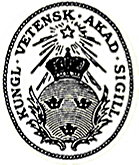Royal Swedish Academy of Sciences

The Royal Swedish Academy of Sciences or Kungliga Vetenskapsakademin ("KVA") is one of the Royal Academies of Sweden. The Academy is an independent, non-governmental scientific organization which acts to promote the sciences, primarily the natural sciences and mathematics.
The Academy was founded on 2 June 1739 by naturalist Carl Linnaeus, mercantilist Jonas Alströmer, mechanical engineer Mårten Triewald, civil servants Sten Carl Bielke and Carl Wilhelm Cederhielm, and politician Anders Johan von Höpken.[1]
The purpose of the academy was to focus on practically useful knowledge, and to publish in Swedish in order to widely disseminate the academy's findings. The academy was intended to be different from the Royal Society of Sciences in Uppsala, which had been founded in 1719 and published in Latin. The location close to the commercial activities in Sweden's capital (which unlike Uppsala did not have a university at this time) was also intentional. The academy was modeled after the Royal Society of London and Academie Royale des Sciences in Paris, France, which some of the founding members were familiar with.
Committees of the Academy act as selection boards for international prizes:
- Nobel Prizes in Physics and Chemistry[2]
- Sveriges Riksbank Prize in Economic Sciences in Memory of Alfred Nobel[3] (also known as the Nobel Memorial Prize in Economics)
- Crafoord Prizes in astronomy and mathematics, geosciences, biosciences (with an emphasis on ecology), and polyarthritis (rheumatoid arthritis)[4]
- Rolf Schock Prizes in logic and philosophy[5]
- Gregori Aminoff Prize in crystallography[6]
- Oskar Klein medal
and national prizes:[7]
- Göran Gustafsson Prizes for research in the natural sciences and medicine
- Söderberg Prize in economics or jurisprudence
- Tage Erlander Prize in physics, chemistry, technology, and biology
- Ingvar Lindqvist Prizes for teachers in the fields of physics, chemistry, biology and mathematics.
Contents |
List of permanent secretaries
The following persons have served as permanent secretaries of the Academy:
- Anders Johan von Höpken, 1739-1740, 1740-1741
- Augustin Ehrensvärd, April-June 1740
- Jacob Faggot, 1741-1744
- Pehr Elvius, 1744-1749
- Pehr Wilhelm Wargentin, 1749-1783
- Johan Carl Wilcke and Henrik Nicander, 1784-1796
- Daniel Melanderhjelm and Henrik Nicander, 1796-1803
- Jöns Svanberg and Carl Gustaf Sjöstén 1803-1808; Sjöstén was removed 1808 for negligence of his duties
- Jöns Svanberg, 1809-1811
- Olof Swartz, 1811-1818
- Jöns Jacob Berzelius, 1818-1848
- Peter Fredrik Wahlberg, 1848-1866
- Georg Lindhagen, 1866-1901
- Christopher Aurivillius, 1901-1923
- Henrik Gustaf Söderbaum, 1923-1933
- Henning Pleijel, 1933-1943
- Arne Westgren, 1943-1959
- Erik Rudberg, 1959-1972
- Carl Gustaf Bernhard, 1973-1981
- Tord Ganelius, 1981-1989
- Carl-Olof Jacobson, 1989-1997
- Erling Norrby, 1997 - 30 June 2003
- Gunnar Öquist, 1 July 2003 - 30 June 2010
- Staffan Normark, appointed from 1 July 2010
Publications

The transactions of the Academy (Vetenskapsakademiens handlingar) were published as its main series between 1739 and 1974. In parallel, other major series have appeared and gone:
- Öfversigt af Kungl. Vetenskapsakademiens förhandlingar (1844-1903)
- Bihang till Vetenskapsakademiens Handlingar (1872-1902)
- Vetenskapsakademiens årsbok (1903-1969)
The Academy started to publish annual reports in physics and chemistry (1826), technology (1827), botany (1831), and zoology (1832). These lasted into the 1860s, when they were replaced by the single Bihang series (meaning: supplement to the transactions). Starting in 1887, this series was once again split into four sections (afdelning), which in 1903 became independent scientific journals of their own, now titled "Arkiv för..." (archive for...). Further restructuring of their topics occurred in 1949 and 1974.
The Academy's first online-only (born digital) journal is Electronic Transactions on Artificial Intelligence or "ETAI" (ISSN 1403-3534). It was founded in 1997 by Erik Sandewall, professor of computer science at Linköping University.
- Current publications
- Ambio (1972-)
- Acta Mathematica (1882-)
- Arkiv för matematik (1949- with this title; 1903-1949 also including physics and astronomy)
- Acta Zoologica (1920-)
- Levnadsteckningar över Vetenskapsakademiens ledamöter (1869-), biographies of deceased members
- Physica Scripta (1970-), jointly with the Norwegian Academy of Science and Letters
- Porträttmatrikel (1971-), portraits of current members
- Zoologica Scripta (1972-), jointly with the Norwegian Academy of Science and Letters
- ETAI (1997-)
See also

- Members of the Royal Swedish Academy of Sciences
References
- ↑ "History". The Royal Swedish Academy of Sciences. http://www.kva.se/en/About-the-academy/History/. Retrieved 2009-10-18.
- ↑ "Nobel Prizes". The Royal Swedish Academy of Sciences. http://www.kva.se/en/Prizes/Nobelprises/. Retrieved 2009-10-18.
- ↑ "Prize in Economic Sciences". The Royal Swedish Academy of Sciences. http://www.kva.se/en/Prizes/Prize-in-Economic-Sciences/. Retrieved 2009-10-18.
- ↑ "Crafoord Prize". The Royal Swedish Academy of Sciences. http://www.kva.se/en/Prizes/Crafoord-Prize/. Retrieved 2009-10-18.
- ↑ "Rolf Schock Prizes". The Royal Swedish Academy of Sciences. http://www.kva.se/en/Prizes/Rolf-Shock-prisen/. Retrieved 2009-10-18.
- ↑ "Gregori Aminoff Prize". The Royal Swedish Academy of Sciences. http://www.kva.se/en/Prizes/Gregori-Aminoff-Prize/. Retrieved 2009-10-18.
- ↑ "National prizes". The Royal Swedish Academy of Sciences. http://www.kva.se/KVA_Root/eng/awards/national/index.asp?br=ns&ver=6up. Retrieved 2007-10-18.
External links
- The Royal Swedish Academy of Sciences
- ETAI, the journal's website.
|
|||||
| This Sweden-related article is a stub. You can help Wikipedia by expanding it. |
| This article about a scientific organization is a stub. You can help Wikipedia by expanding it. |